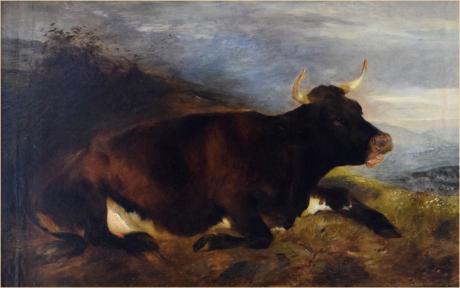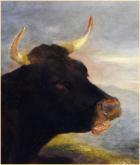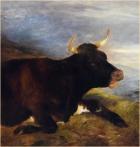signed inscribed and dated on various labels on the reverse
inscribed on a label on the reverse " By Wm Huggins Date 1856" and further inscribed on another label " Exchange Art Gallery Oil Painting The Brown C../ William Hu…"
The Hereford is a British breed of beef cattle originally from Herefordshire in the West Midlands of England. It has spread to many countries – there are more than five million purebred Hereford cattle in over fifty nations worldwide. The breed was first exported from Britain in 1817, initially to Kentucky. It spread across the United States and Canada, through Mexico, to the great beef-raising countries of South America. Today Herefords dominate from Australasia to the Russian steppes, including Israel, Japan, continental Europe and Scandinavia, temperate parts of Australia, Canada, the United States, Kazakhstan and Russia, the centre and east of Argentina, Uruguay, Chile, and New Zealand, where they make up the largest proportion of registered cattle. They are found all over Brazil and in some Southern African countries, notably South Africa, Zambia and Zimbabwe. Their original popularity among ranchers of the American Southwest testified to the hardiness of a breed originating in cool, moist Britain, but shown to thrive in harsher climates on nearly every continent. The World Hereford Council, is based in Britain. There are currently 20 Hereford societies in 17 member-countries and a further eight in 10 non-member countries. In the United States, the official Hereford organization and breed registry is the American Hereford Association, the second-largest society of its kind in the country.
Until the 18th century, the cattle of Herefordshire resembled other cattle of southern England, being wholly red with a white switch, similar to the modern North Devon and Sussex breeds. In the 18th and early 19th centuries, other cattle (mainly Shorthorns) were used to create a new type of draught and beef cattle which at first varied in colour, with herds ranging from yellow to grey and light brown, and with varying amounts of white. By the end of the 18th century the white face characteristic of the modern breed was well established, as was the modern colour during the 19th century.
The Hereford is still seen in the Herefordshire countryside today and featured strongly at agricultural shows. The first imports of Herefords to the United States were made about 1817 by the politician Henry Clay, with larger importation beginning in the 1840s. The Polled Hereford is a hornless variant of Hereford with a polled gene, a natural genetic mutation selected into a separate breed from 1889.
Iowa cattle rancher Warren Gammon capitalised on the idea of breeding Polled Herefords and started the registry with 11 naturally polled cattle. The American Polled Hereford Association (APHA) was formed in 1910. The American Polled Hereford and American Hereford breeds have been combined since 1995 under the same American Hereford Association name. Many strains of Hereford have used other cattle breeds to import desired characteristics, which has led to changes in the breed as a whole. However, some strains have been kept separate and retained characteristics of the earlier breed, such as hardiness and thriftiness. The Traditional Hereford is now treated as a minority breed of value for genetic conservation.
Eye cancer (ocular squamous cell carcinoma) occurs in Herefords, notably in countries with continued bright sunlight and among those that prefer traits of low levels of red pigmentation round the eye. Studies of eye cancer in Hereford cattle in the US and Canada showed lid and corneoscleral pigment to be heritable and likely to decrease the risk of cancer. Vaginal prolapse is considered a heritable problem, but may also be influenced by nutrition.Another problem is exposed skin on the udder being of light pigmentation and so vulnerable to sunburn.
Dwarfism is known to occur in Hereford cattle, caused by an autosomal recessive gene.Equal occurrence in heifers and bulls means that dwarfism is not considered a sex-linked characteristic.
William Huggins (May 1820 – 25 February 1884) was an English artist, from Liverpool, who specialised in drawing animals.
Huggins was a member of the Liverpool Academy of Arts. He enjoyed visiting Wombwell's Travelling Menagerie, an animal circus, and the Liverpool Zoological Gardens. Huggins has been compared to fellow Liverpool artist George Stubbs and is known for keeping his house full of pets. William Huggins was born in Liverpool. His parents were called Samuel and Elizabeth. He received his first instruction in drawing at the Liverpool Mechanics' Institution. He won a prize for "Adam's Vision of the Death of Abel" and successfully entered work to be shown at the Liverpool Academy of Arts whilst fifteen years old. He drew from life using the classes at the Academy of Arts or by sketching the animals in Liverpool's zoo. He travelled further afield to see exotic animals at the unusual Wombwell’s Travelling Menagerie. His animal work was admired and compared to Stubbs. Huggins was magnanimous in acknowledging Stubbs' influence and this contrasts with a later comparison that was made with Landseer where Huggins felt insulted. Huggins pictures of exotic animals were much admired but they are noted for lack of background as Huggins never saw them in their own habitat.
In 1845 Huggins changed his themes away from animals and chickens. His paintings were based on literary themes from Milton, Shelley and Spenser's "The Faerie Queene" and Moore's "Enchantress and Nourmahal" Huggins first exhibited "Androcles and the lion" at the Royal Academy and made successful entries from 1846 until he was in his seventies. In addition he showed his paintings at most of the major cities in Great Britain. He was influenced in his use of glazes by the Pre-Raphaelites who also had exhibitions there. He became a full member of the Liverpool Academy in 1850 (resigning in 1856), but never became an RA (Royal Academician).
In 1861 Huggins moved to Chester where he lived with his brother, Samuel, until 1865. Huggins work at this time moved from animals to buildings (his brother, Samuel was a notable architectural writer). He painted Chester Cathedral which his brother was to go on to defend when it was to be restored. After leaving his brother, he painted the "Stones of Chester, or Ruins of St. John's" (1874) and the "Salmon Trap on the Dee". He moved to Betws-y-Coed in 1876 so that he could paint landscapes. One painting that resulted was, "The Fairy Glen" which was exhibited in Liverpool in 1877.
Huggins eventually moved from Wales and settled in and died in the Cheshire village of Christleton on 25 February 1884] just a year before his brother, Samuel. The brothers were buried in St James' Church, Christleton, and the headstone of their grave is a Grade II listed building.
Huggins' horses, cattle, and poultry pictures were his best and most characteristic work, good in drawing, and remarkable for brilliance of colour. "Tried Friends", purchased by the Liverpool corporation, illustrates his use of transparent glazes over a white ground. Huggins' preferred medium was painting on white millboard from pencil outlines.
Huggins portrait include one of the master of the Holcombe Hunt, his brother Samuel and himself. He included his wife in "Aerial combat, the fight between the Eagle and the Serpent" which he painted in his literary phase and which illustrated Shelley's "Revolt of Islam."
Huggins has nearly 60 paintings in public collections in the United Kingdom.
According to art-historian and gallery owner Rupert Maas, "Huggins was an eccentric individual. He preferred the company of animals, especially chickens, than of his fellow men. He hated travelling through tunnels, and so would get off the train before Liverpool and walk the rest of the way home. His epitaph, which he composed himself, read: 'A just and compassionate man who would neither tread on a worm, nor cringe to an Emperor'."




